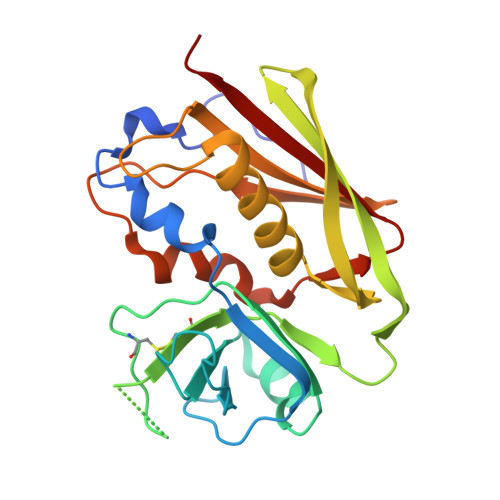Contribution of the flexible loop region to the function of staphylococcal enterotoxin B
Yanaka, S., Kudou, M., Tanaka, Y., Sasaki, T., Takemoto, S., Sakata, A., Hattori, Y., Koshi, T., Futaki, S., Tsumoto, K., Nakashima, T.(2010) Protein Eng Des Sel 23: 415-421
- PubMed: 20181657
- DOI: https://doi.org/10.1093/protein/gzq006
- Primary Citation of Related Structures:
3GP7 - PubMed Abstract:
Staphylococcal enterotoxin B (SEB), a toxin produced by Staphylococcus aureus, causes food poisoning and other fatal diseases by inducing high levels of pro-inflammatory cytokines. These cytokines are released from CD4+ T cells and major histocompatibility complex (MHC) class II antigen-presenting cells, which are activated through binding of wild-type (WT) SEB to both the MHC class II molecule and specific T-cell receptor Vbeta chains. Here, we focused on a trypsin/cathepsin cleavage site of WT SEB, which is known to be cleaved in vivo between Lys97 and Lys98, located within the loop region. To know the function of the cleavage, an SEB mutant, in which both of these Lys residues have been changed to Ser, was examined. This mutant showed prolonged tolerance to protease cleavage at a different site between Thr107 and Asp108, and structural analyses revealed no major conformational differences between WT SEB and the mutant protein. However, differential scanning calorimetric analysis showed an increase in enthalpy upon thermal denaturation of the mutant protein, which correlated with the speed of cleavage between Thr107 and Asp108. The mutant protein also had slightly increased affinity for MHC. In the in vivo experiment, the SEB mutant showed lower proliferative response in peripheral blood mononuclear cells and had lower cytokine-induction activity, compared with WT SEB. These results highlight the importance of the flexible loop region for the functional, physical and chemical properties of WT SEB, thus providing insight into the nature of WT SEB that was unrevealed previously.
- Department of Medical Genome Sciences, Graduate School of Frontier Sciences, The University of Tokyo, Tokyo, Japan.
Organizational Affiliation:
















